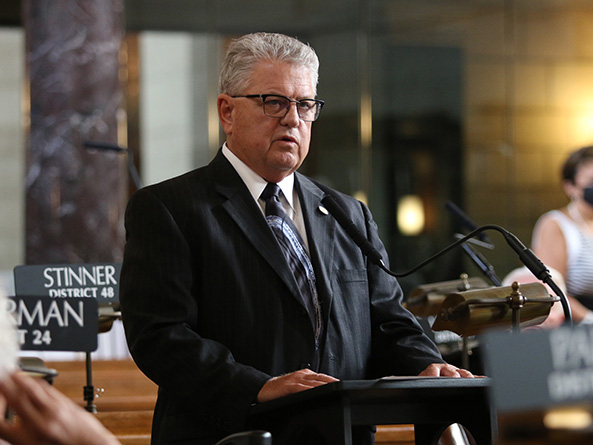Legislative redistricting plan stalls
A proposal to redraw Nebraska’s 49 legislative districts to reflect changes in the state’s population fell six votes short on a motion to end general file debate Sept. 20.
Sen. Lou Ann Linehan of Elkhorn, Redistricting Committee chairperson, said Nebraska’s population grew at roughly the same rate as the country as a whole but that growth was not evenly distributed throughout the state.
She said three districts in the eastern portion of Nebraska — 10, 39 and 49 — grew substantially, meaning parts of those districts must become part of a newly created district in Douglas or Sarpy counties to meet population requirements.
Linehan said lawmakers also will have to change the boundaries of some districts in Douglas County that did not grow at the same rate as the rest of the state. And although the committee worked to “keep as much of rural Nebraska represented as we possibly can,” she said, most districts west of Kearney must change dramatically due to population loss.
“Understand that it’s not personal,” Linehan said. “It’s just a math problem.”
To account for a population shift from west to east, her proposal in LB3 would combine existing districts 23 and 24 and create a new District 24 in southwestern Sarpy and southeastern Saunders counties.
An alternative plan in LB4, created by Omaha Sen. Justin Wayne, would even out district populations by moving District 44 from southwestern Nebraska to southwestern Douglas and western Sarpy counties.
Venango Sen. Dan Hughes said LB3 would leave his District 44 “relatively intact,” while Wayne’s plan would divide its 10 counties among several legislative districts. Hughes said further expanding western Nebraska legislative districts by moving District 44 would make it even more difficult for those senators to represent their constituents.
“That’s a disservice to those citizens,” he said. “We’re denying them access to their senators because of the great distances we have to travel.”
Sen. Adam Morfeld of Lincoln said lawmakers must consider population data when redrawing district maps, not geographic area or other considerations.
“Land is not people,” he said. “People are people — that is what we are redistricting with.”
Under guidelines adopted by the Legislature last session in LR134, senators may not consider a legislative redistricting plan that results in an overall range of deviation of more than 10 percent or a relative deviation of more than 5 percent from the ideal population.
Also in support of LB3 was Albion Sen. Tom Briese. With the exception of District 24, he said, the bill recognizes the importance of preserving the core of prior districts. Briese said that goal, which the LR134 guidelines allow for, enhances continuity and consistency in representation.
“By necessity, in LB3, one and only one proposed district does not contain a portion of the old,” he said.
Among other requirements, LR134 also stipulates that district boundaries follow county lines whenever practicable and, as far as possible, define districts that are easily identifiable and understandable to voters and preserve communities of interest.
Several senators who opposed LB3 said the proposal would not follow those guidelines.
Sen. Anna Wishart of Lincoln said it would move 10 of 14 neighborhoods from her District 27 into other districts for “no reason other than partisanship.”
“If you look at LB3 … it is pretty much 70 percent [a] different district than the one I was just elected in,” she said.
Omaha Sen. Machaela Cavanaugh said she would lose approximately 80 percent of her current District 6 constituents under Linehan’s proposal, for what she also said were partisan reasons.
Sen. Jen Day of Omaha said LB3 would remove or split in half every community of interest in the current District 49, which she represents, including Papillion, La Vista, Chalco and Gretna.
Under Linehan’s proposal, she said, many of the residents in her primarily suburban district would become constituents of the new, primarily rural, District 24.
“You cannot tell me that there is any attempt that was made at maintaining the core or preserving communities of interest when it came to LD49,” Day said.
Omaha Sen. Steve Lathrop also opposed LB3. He said Linehan’s map uses the population deviation allowance — which is intended to give lawmakers leeway to avoid splitting a town or county between legislative districts — to create rural districts with smaller populations than urban ones.
“If it’s not gerrymandering, it’s deviation-mandering,” Lathrop said. “We’re going to game the deviation to blunt the consequences of population loss west of Kearney and then stand up and say we’re doing this to preserve the core of the district.”
Lincoln Sen. Matt Hansen introduced an amendment that would replace Linehan’s proposal with the plan outlined in Wayne’s LB4.
Hansen said he introduced the amendment to give lawmakers an opportunity to compare the competing proposals, which he called nearly identical in some places.
Sen. Mark Kolterman of Seward said it would be possible to preserve the core of his District 24 with “just a few tweaks.” Kolterman introduced an amendment to Hansen’s amendment that he said would more or less keep his district intact, along with districts 30 and 32, represented by Adams Sen. Myron Dorn and Sen. Tom Brandt of Plymouth, respectively.
Hansen supported Kolterman’s amendment, saying it would modify boundary lines for 10 districts in Lincoln and southern Lancaster County. He said the associated map fits within an eight-county section of Wayne’s legislative redistricting plan.
Senators voted 26-21 to adopt Kolterman’s amendment.
After eight hours of first-round debate, Linehan filed a motion to invoke cloture, which ceases debate and forces a vote on a bill. The motion failed on a vote of 27-18. Thirty-three votes were needed.
A failed cloture motion ends debate on a bill for the day.


